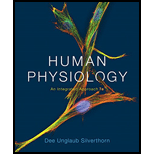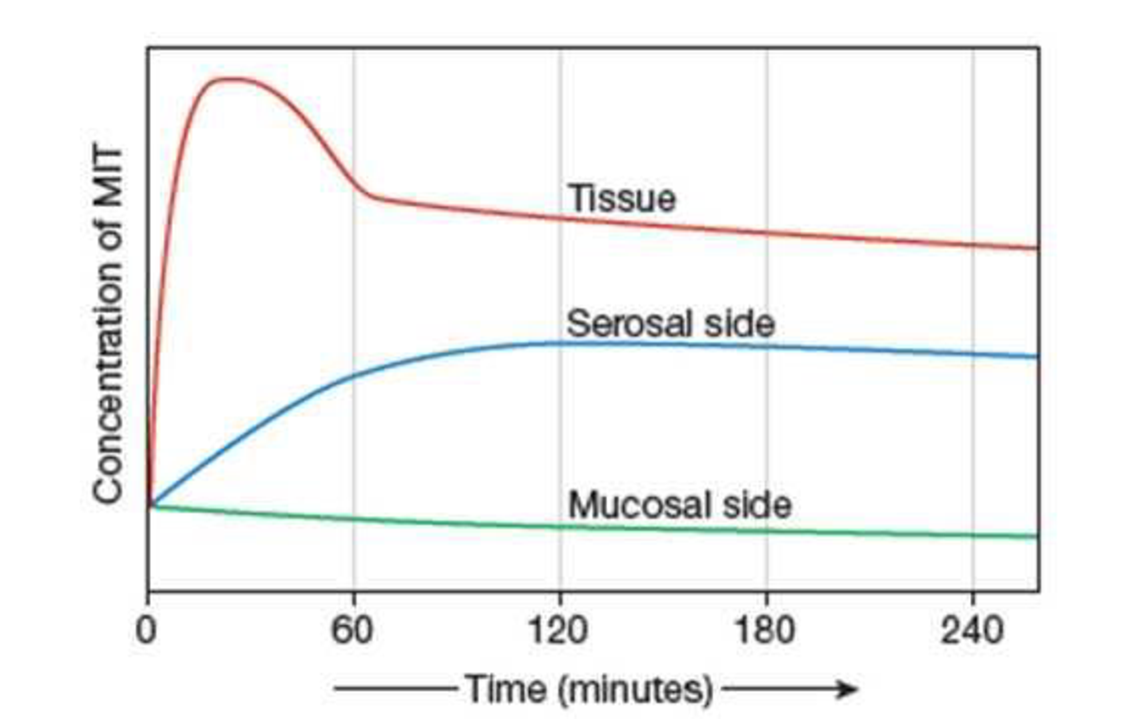
EBK HUMAN PHYSIOLOGY
7th Edition
ISBN: 9780133983401
Author: Silverthorn
Publisher: YUZU
expand_more
expand_more
format_list_bulleted
Textbook Question
Chapter 21, Problem 25RQ
Intestinal transport of the amino acid analog MIT (monoiodotyrosine) can be studied using the “everted sac” preparation. A length of intestine is turned inside out, filled with a solution containing MIT, tied at both ends, and then placed in a bath containing nutrients, salts, and an equal concentration of MIT. Changes in the concentration of MIT are monitored in the bath (mucosal or apical side of the inverted intestine), in the intestinal cells (tissue), and within the sac (serosal or basolateral side of the intestine) over a 240-minute period. The results are displayed in the graph shown here. (Data from Nathans et al., Biochimica et Biophysica Acta 41: 271–282, 1960.)
- a. Based on the data shown, is the transepithelial transport of MIT a passive process or an active process?
- b. Which way does MIT move: (1) apical to tissue to basolateral, or (2) basolateral to tissue to apical? Is this movement absorption or secretion?
- c. Is transport across the apical membrane active or passive? Explain your reasoning.
- d. Is transport across the basolateral membrane active or passive? Explain your reasoning.

Expert Solution & Answer
Want to see the full answer?
Check out a sample textbook solution
Students have asked these similar questions
Imagine that you are a clinical geneticist. Your colleague is an oncologist who wants your help explaining the basics of genetics to their patient, who will be undergoing genetic testing in the coming weeks for possible acute myeloid leukemia (AML) induced by the radiation she had several years ago for breast cancer.
Write a 1,050- to 1,225-word memo to your colleague.
Include the following in your memo:
An explanation of the molecular structure of DNA and RNA, highlighting both similarities and differences
A description of the processes of transcription and translation
An explanation of the differences between leading and lagging strands and how the DNA is replicated in each strand
Reponses to the following common questions patients might ask about this type of genetic testing and genetic disorder:
Does AML run in families?
What genes are tested for?
Respond to the following in a minimum of 175 words:
What are some potential consequences that could result if the processes of replication, transcription, and translation don’t function correctly?
Provide an example of how you might explain these consequences in terms that patients might understand.
answer questions 1-10
Chapter 21 Solutions
EBK HUMAN PHYSIOLOGY
Ch. 21 - Prob. 1CCCh. 21 - Prob. 2CCCh. 21 - Prob. 3CCCh. 21 - Define digestion. What is the difference between...Ch. 21 - Prob. 5CCCh. 21 - Draw a cell showing (1) an enzyme in a cytoplasmic...Ch. 21 - Prob. 7CCCh. 21 - Prob. 8CCCh. 21 - Prob. 9CCCh. 21 - Prob. 10CC
Ch. 21 - Prob. 11CCCh. 21 - Do bile salts digest triglycerides into...Ch. 21 - Prob. 13CCCh. 21 - Prob. 14CCCh. 21 - What activates pepsinogen, trypsinogen, and...Ch. 21 - Prob. 16CCCh. 21 - Match each of the following descriptions with the...Ch. 21 - Prob. 2RQCh. 21 - Prob. 3RQCh. 21 - Prob. 4RQCh. 21 - Prob. 5RQCh. 21 - Prob. 6RQCh. 21 - What purposes does motility serve in the...Ch. 21 - Prob. 8RQCh. 21 - Match each of the following cells with the...Ch. 21 - Prob. 10RQCh. 21 - Prob. 11RQCh. 21 - Prob. 12RQCh. 21 - Prob. 13RQCh. 21 - What role do paracrines play in digestion? Give...Ch. 21 - Prob. 15RQCh. 21 - Prob. 16RQCh. 21 - Prob. 17RQCh. 21 - Prob. 18RQCh. 21 - Prob. 19RQCh. 21 - Prob. 20RQCh. 21 - Prob. 21RQCh. 21 - Prob. 22RQCh. 21 - Mary Littlefeather arrives in her physicians...Ch. 21 - Using what you have learned about epithelial...Ch. 21 - Intestinal transport of the amino acid analog MIT...
Knowledge Booster
Learn more about
Need a deep-dive on the concept behind this application? Look no further. Learn more about this topic, biology and related others by exploring similar questions and additional content below.Similar questions
- Answer Question 1-9arrow_forwardEx: Mr. Mandarich wanted to see if the color of light shined on a planthad an effect on the number of leaves it had. He gathered a group ofthe same species of plants, gave them the same amount of water, anddid the test for the same amount of time. Only the color of light waschanged. IV:DV:Constants:Control Gr:arrow_forwardethical considerations in medical imagingarrow_forward
- Please correct answer and don't used hand raiting and don't used Ai solutionarrow_forward2. In one of the reactions of the citric acid cycle, malate is oxidized to oxaloacetate. When this reaction is considered in isolation, a small amount of malate remains and is not oxidized. The best term to explain this is a. enthalpy b. entropy c. equilibrium d. free energy e. loss of energyarrow_forward18. The citric acid cycle takes place in a. the chloroplasts b. the cytosol c. the inner mitochondrial membrane d. between the two mitochondrial membranes e. the mitochondrial matrix 40 WILarrow_forward
- 8. Most reactions of anaerobic respiration are similar to a. aerobic respiration b. photosynthesis c. lactic acid fermentation d. alcoholic fermentation e. both c and darrow_forward12. Which of the following molecules can absorb light? a. Pigments b. Chlorophyll c. Rhodopsin d. Carotenoids e. All of the abovearrow_forwardWhich of the following proteins or protein complexes is directly required for the targeting of mitochondrial inner membrane multipass proteins, such as metabolite transporters, whose signal sequence is normally not cleaved after import? OA. TIM22 OB. TIM23 C. OXA OD. Mia40 OE SAMarrow_forward
- QUESTION 9 An animal cell has been wounded and has a small rupture in its plasma membrane. Which of the following is more likely to happen next? OA. The cell rapidly cleaves by cytokinesis. OB. The rate of receptor-mediati endocytosis is increased. OC. The rate of exocytosis is increased. OD. The rate of pinocytosis is increased.arrow_forwardFor the a subunit of a trimeric G protein, A. a G-protein-coupled receptor GPCR) acts as a guanine nucleotide exchange factor (GEF), whereas a regulator of G protein signaling (RGS) can act as a GTPase-activating protein (GAP). B. a GPCR acts as a GAP, whereas an RGS can act as a GEF. C. both a GPCR and an RGS can act as a GEF. O D. both a GPCR and an RGS can act as a GAP OE. None of the above.arrow_forwardA cell expresses a transmembrane protein that is cleaved at the plasma membrane to release an extracellular fragment. The fragment binds to receptor proteins on nearby cells and activates signaling pathways resulting in altered gene expression patterns in the cells. What form of intercellular signaling does this represent? OA. Contact-dependent signaling B. Paracrine signaling OC. Synaptic signaling D. Endocrine signaling E. Autocrine signalingarrow_forward
arrow_back_ios
SEE MORE QUESTIONS
arrow_forward_ios
Recommended textbooks for you
 Human Physiology: From Cells to Systems (MindTap ...BiologyISBN:9781285866932Author:Lauralee SherwoodPublisher:Cengage Learning
Human Physiology: From Cells to Systems (MindTap ...BiologyISBN:9781285866932Author:Lauralee SherwoodPublisher:Cengage Learning Biology 2eBiologyISBN:9781947172517Author:Matthew Douglas, Jung Choi, Mary Ann ClarkPublisher:OpenStax
Biology 2eBiologyISBN:9781947172517Author:Matthew Douglas, Jung Choi, Mary Ann ClarkPublisher:OpenStax

Human Physiology: From Cells to Systems (MindTap ...
Biology
ISBN:9781285866932
Author:Lauralee Sherwood
Publisher:Cengage Learning





Biology 2e
Biology
ISBN:9781947172517
Author:Matthew Douglas, Jung Choi, Mary Ann Clark
Publisher:OpenStax
Human digestive system - How it works! (Animation); Author: Thomas Schwenke;https://www.youtube.com/watch?v=X3TAROotFfM;License: Standard Youtube License